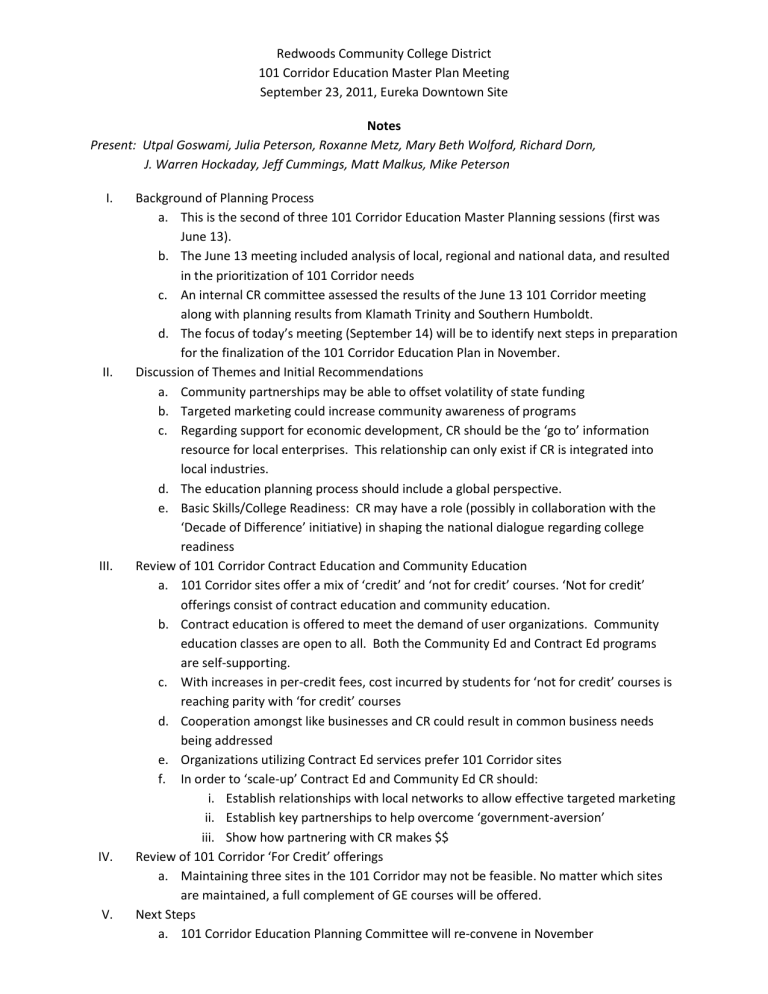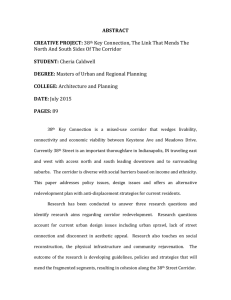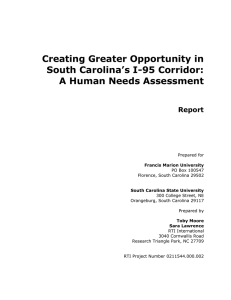Redwoods Community College District 101 Corridor Education Master Plan Meeting

Redwoods Community College District
101 Corridor Education Master Plan Meeting
September 23, 2011, Eureka Downtown Site
Notes
Present: Utpal Goswami, Julia Peterson, Roxanne Metz, Mary Beth Wolford, Richard Dorn,
J. Warren Hockaday, Jeff Cummings, Matt Malkus, Mike Peterson
I.
Background of Planning Process a.
This is the second of three 101 Corridor Education Master Planning sessions (first was
June 13). b.
The June 13 meeting included analysis of local, regional and national data, and resulted in the prioritization of 101 Corridor needs c.
An internal CR committee assessed the results of the June 13 101 Corridor meeting along with planning results from Klamath Trinity and Southern Humboldt. d.
The focus of today’s meeting (September 14) will be to identify next steps in preparation for the finalization of the 101 Corridor Education Plan in November.
II.
Discussion of Themes and Initial Recommendations a.
Community partnerships may be able to offset volatility of state funding b.
Targeted marketing could increase community awareness of programs c.
Regarding support for economic development, CR should be the ‘go to’ information resource for local enterprises. This relationship can only exist if CR is integrated into local industries. d.
The education planning process should include a global perspective. e.
Basic Skills/College Readiness: CR may have a role (possibly in collaboration with the
‘Decade of Difference’ initiative) in shaping the national dialogue regarding college readiness
III.
Review of 101 Corridor Contract Education and Community Education a.
101 Corridor sites offer a mix of ‘credit’ and ‘not for credit’ courses. ‘Not for credit’ offerings consist of contract education and community education. b.
Contract education is offered to meet the demand of user organizations. Community education classes are open to all. Both the Community Ed and Contract Ed programs are self-supporting. c.
With increases in per-credit fees, cost incurred by students for ‘not for credit’ courses is reaching parity with ‘for credit’ courses d.
Cooperation amongst like businesses and CR could result in common business needs being addressed e.
Organizations utilizing Contract Ed services prefer 101 Corridor sites f.
In order to ‘scale-up’ Contract Ed and Community Ed CR should: i.
Establish relationships with local networks to allow effective targeted marketing ii.
Establish key partnerships to help overcome ‘government-aversion’ iii.
Show how partnering with CR makes $$
IV.
Review of 101 Corridor ‘For Credit’ offerings a.
Maintaining three sites in the 101 Corridor may not be feasible. No matter which sites are maintained, a full complement of GE courses will be offered.
V.
Next Steps a.
101 Corridor Education Planning Committee will re-convene in November





